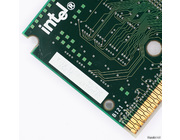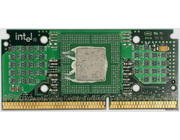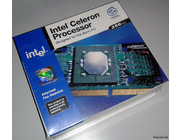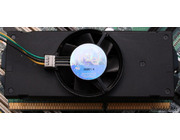The first Celeron processor Intel released. It was essentially a cut-down Pentium II as it didn't have any L2-cache at all. Due the lack of L2-cache the new Celerons were a good deal slower, but gained overclockability because the old off-die L2-cache is more difficult to overclock.
At first the new Celeron sold fairly good because of Intel's reputation/name but people found out that it didn't had the performance they hoped it would have. This hurted the name Celeron. Intel repaired their mistake by releasing Covington's successor, the Mendocino.
I have three Celeron 266's: this SL2SY, a boxed SL2YN and a CPU only SL2YN. The SL2SY is the OEM-version and didn't come with Intel's shroud-cooling solution.
Somehow I've liked the first Celeron's for it's box-art and the way the boxed cooler looks. However, performance was sub-par due the lack of L2-cache. Luckily 'Covington' was quickly succeeded by 'Mendocino' which was basically the same CPU but with 128KB on-die full speed L2-cache. Those CPU's performed very well and were also quite overclockable. > Read more
As stated here the Covington-based Celeron is not a wonderful performer. It does it's job but the lack of L2-cache is noticeable in multi-tasking and specific applications/games.
However, due te absent L2-cache it is a highly overclockable processor. My CPU easily runs at a 100MHz FSB (which results in a Celeron 450 without L2-cache). To give you an insight on the performance it delivers at 450MHz: CPUMark '99 gives 22 points which is slightly better than a Pentium II 266 and Quake II scores 22.9 FPS which is better than the Pentium II 350 and Celeron 400.
Using stock cooling and no vCore increase it even boots up at 504MHz (112FSB). I'm sure that it'll run just fine over 500MHz with a little bit of extra vCore. > Read more
A boxed version of the first Celeron series. Basically the Celeron Covington is a Pentium II without L2-cache. This reduces production costs but also causes performance to drop. No L2-cache at all is not good. It's successor, the Celeron Mendocino, had 128K2 full-speed on-die cache which greatly improved the CPU.
I like the box-art of the Celeron 266. A blue little box showing the hardware that is underneath the black plastic shroud. > Read more
Technically a dreadful CPU! It's basically a Pentium II (which doesn't sound to bad) but without L2 cache. It has none, nothing. This impacts overall performance of the CPU and above all: it feels slow when running Windows '98. Surprisingly some benchmarks are nearly as fast as a Pentium II 233. I suspect those benchmarks don't need much L2 cache at all.
Luckily Intel decided to get rid of the 'Covington' processor fairly quick. After releasing the 266 and 300MHz models they started shipping the so called 'Mendocino', the same as Covington but with 128KB full-speed on-die L2 cache. Technically speaking Intel used their best L2 'method' for their budget CPU because the Pentium II only has off-die L2 cache at just half the clock frequency of the CPU. However, the L2 cache of the Pentium II was bigger with 512KB in total which seems to get things straight again.
Despite that this CPU is 'dreadful' (regarding performance) I think it has a certain flair to it. It's the first Celeron and first time that Intel ran two lines for the desktop market (Celeron as budget, Pentium II for high-end). In 1998 I was fond of the first Mendocino CPU's but looking back nowadays I kind of like the Covington.
Running two lines (high-end and low-end) had another big advantage for Intel in 1998: Pentium II's predecessor, the Pentium MMX, used socket 7 systems which also hosted CPU's from other manufacturers (i.e. AMD and Cyrix). To increase adoption of the Slot 1 motherboards (which was only used by Intel) and to decrease the use of motherboards that could also be used by other manufacturers, Intel decided to use a budget CPU on Slot 1. > Read more



